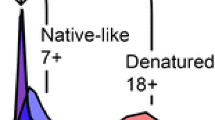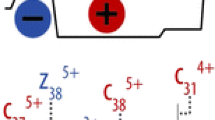Abstract
We have developed a method for rapidly quantifying the extent to which the functionally important Met144 and Met145 residues near the C-terminus of calmodulin (CaM) are converted to the corresponding sulfoxides, Met(O). The method utilizes a whole protein collision-induced dissociation (CID) approach on an electrospray ionization quadrupole time-of-flight (ESI-Q-TOF) mass spectrometer. Using standards of CaM oxidized by hydrogen peroxide (H2O2) or peroxynitrite (ONOO−), we demonstrated that CID fragmentation of the protein ions resulted in a series of C-terminal singly charged y1–y15 ions. Fragments larger than y4 exhibited mass shifts of +16 or +32 Da, corresponding to oxidation of one or two methionines, respectively. To assess the extent of oxidative modification for Met144 and Met145 to Met(O), we averaged the ratio of intensities for y n , y n + 16, and y n + 32 ions, where n = 6–9. By alternating MS and CID scans at low and high collision energies, this technique allowed us to rapidly determine both the distribution of intact CaM oxiforms and the extent of oxidative modification in the C-terminal region of the protein in a single run. We have applied the method to studies of the repair of fully oxidized CaM by methionine sulfoxide reductases (MsrA and MsrB), which normally function in concert to reduce the S and R stereoisomers of methionine sulfoxide. We found that repair of Met(O)144 and Met(O)145 did not go to completion, but was more efficient than average Met repair. Absence of complete repair is consistent with previous studies showing that accumulation of methionine sulfoxide in CaM can occur during aging (Gao, J.; Yin, D.; Yao, Y.; Williams, T. D.; Squier, T. C. Biochemistry 1998, 37, 9536–9548).
Similar content being viewed by others
References
Reid, G. E.; McLuckey, S. A. “Top down” protein characterization via tandem mass spectrometry. J. Mass Spectrom. 2002, 37, 663–675.
Stephenson, J. L.; McLuckey, S. A.; Reid, G. E.; Wells, J. M.; Bundy, J. L. Ion/ion chemistry as a top-down approach for protein analysis. Curr. Opin. Biotechnol. 2002, 13, 57–64.
Kelleher, N. L.; Taylor, S. V.; Grannis, D.; Kinsland, C.; Chiu, H. J.; Begley, T. P.; McLafferty, F. W. Efficient sequence analysis of the six gene products (7–74 kDa) from the Escherichia coli thiamin biosynthetic operon by tandem high-resolution mass spectrometry. Protein Sci. 1998, 7, 1796–1801.
Nemeth-Cawley, J. F.; Rouse, J. C. Identification and sequencing analysis of intact proteins via collision-induced dissociation and quadrupole time-of-flight mass spectrometry. J. Mass Spectrom. 2002, 37, 270–282.
Nemeth-Cawley, J. F.; Tangarone, B. S.; Rouse, J. C. “Top Down” characterization is a complementary technique to peptide sequencing for identifying protein species in complex mixtures. J. Proteome Res. 2003, 2, 495–505.
Reid, G. E.; Shang, H.; Hogan, J. M.; Lee, G. U.; McLuckey, S. A. Gas-phase concentration, purification, and identification of whole proteins from complex mixtures. J. Am. Chem. Soc. 2002, 124, 7353–7362.
Thevis, M.; Loo, R. R.; Loo, J. A. Mass spectrometric characterization of transferrins and their fragments derived by reduction of disulfide bonds. J. Am. Soc. Mass Spectrom. 2003, 14, 635–647.
Reid, G. E.; Stephenson J. L., Jr.; McLuckey, S. A. Tandem mass spectrometry of ribonuclease A and B: N-linked glycosylation site analysis of whole protein ions. Anal. Chem. 2002, 74, 577–583.
Zhou, N.; Yuan, T.; Mak, A. S.; Vogel, H. J. NMR studies of caldesmon—calmodulin interactions. Biochemistry 1997, 36, 2817–2825.
Edwards, R. A.; Walsh, M. P.; Sutherland, C.; Vogel, H. J. Activation of calcineurin and smooth muscle myosin light chain kinase by Met-to-Leu mutants of calmodulin. Biochem. J. (Part 1) 1998, 331, 149–152.
Vetter, S. W.; Leclerc, E. Novel aspects of calmodulin target recognition and activation. Eur. J Biochem 2003, 270, 404–414.
Yao, Y.; Squier, T. C. Variable conformation and dynamics of calmodulin complexed with peptides derived from the autoinhibitory domains of target proteins. Biochemistry 1996, 35, 6815–6827.
Carafoli, E.; Garcia-Martin, E.; Guerini, D. The plasma membrane calcium pump: Recent developments and future perspectives. Experientia 1996, 52, 1091–1100.
Strehler, E. E.; Zacharias, D. A. Role of alternative splicing in generating isoform diversity among plasma membrane calcium pumps. Physiol. Rev. 2001, 81, 21–50.
Lehotsky, J. Plasma membrane Ca(2+)-pump functional specialization in the brain. Complex of isoform expression and regulation by effectors. Mol. Chem. Neuropathol. 1995, 25, 175–187.
Guerini, D.; Krebs, J.; Carafoli, E. Stimulation of the purified erythrocyte Ca2+-ATPase by tryptic fragments of calmodulin. J. Biol. Chem. 1984, 259, 15172–15177.
Elshorst, B.; Hennig, M.; Forsterling, H.; Diener, A.; Maurer, M.; Schulte, P.; Schwalbe, H.; Griesinger, C.; Krebs, J.; Schmid, H.; Vorherr, T.; Carafoli, E. NMR solution structure of a complex of calmodulin with a binding peptide of the Ca2+ pump. Biochemistry 1999, 38, 12320–12332.
Yao, Y.; Gao, J.; Squier, T. C. Dynamic structure of the calmodulin-binding domain of the plasma membrane Ca-ATPase in native erythrocyte ghost membranes. Biochemistry 1996, 35, 12015–12028.
Sun, H.; Squier, T. C. Ordered and cooperative binding of opposing globular domains of calmodulin to the plasma membrane Ca-ATPase. J. Biol. Chem. 2000, 275, 1731–1738.
Squier, T. C. Oxidative stress and protein aggregation during biological aging. Exp. Gerontol. 2001, 36, 1539–1550.
Michaelis, M. L.; Bigelow, D. J.; Schoneich, C.; Williams, T. D.; Ramonda, L.; Yin, D.; Huhmer, A. F.; Yao, Y.; Gao, J.; Squier, T. C. Decreased plasma membrane calcium transport activity in aging brain. Life Sci. 1996, 59, 405–412.
Gao, J.; Yin, D.; Yao, Y.; Williams, T. D.; Squier, T. C. Progressive decline in the ability of calmodulin isolated from aged brain to activate the plasma membrane Ca-ATPase. Biochemistry 1998, 37, 9536–9548.
Gao, J.; Yao, Y.; Squier, T. C. Oxidatively modified calmodulin binds to the plasma membrane Ca-ATPase in a nonproductive and conformationally disordered complex. Biophys. J. 2001, 80, 1791–1801.
Yin, D.; Kuczera, K.; Squier, T. C. The sensitivity of carboxyl-terminal methionines in calmodulin isoforms to oxidation by H(2)O(2) modulates the ability to activate the plasma membrane Ca-ATPase. Chem. Res. Toxicol. 2000, 13, 103–110.
Bartlett, R. K.; Bieber Urbauer, R. J.; Anbanandam, A.; Small-wood, H. S.; Urbauer, J. L.; Squier, T. C. Oxidation of Met144 and Met145 in calmodulin blocks calmodulin dependent activation of the plasma membrane Ca-ATPase. Biochemistry 2003, 42, 3231–3238.
Montgomery, H. J.; Bartlett, R.; Perdicakis, B.; Jervis, E.; Squier, T. C.; Guillemette, J. G. Activation of constitutive nitric oxide synthases by oxidized calmodulin mutants. Biochemistry 2003, 42, 7759–7768.
Qin, Z.; Squier, T. C. Calcium-dependent stabilization of the central sequence between Met(76) and Ser(81) in vertebrate calmodulin. Biophys. J. 2001, 81, 2908–2918.
Klee, C. B.; Vanaman, T. C. Calmodulin. Adv. Protein Chem. 1982, 35, 213–321.
Strasburg, G. M.; Hogan, M.; Birmachu, W.; Thomas, D. D.; Louis, C. F. Site-specific derivatives of wheat germ calmodulin. Interactions with troponin and sarcoplasmic reticulum. J. Biol. Chem. 1988, 263, 542–548.
Smallwood, H. S.; Galeva, N. A.; Bartlett, R. K.; Urbauer, R. J.; Williams, T. D.; Urbauer, J. L.; Squier, T. C. Selective nitration of Tyr99 in calmodulin as a marker of cellular conditions of oxidative stress. Chem. Res. Toxicol. 2003, 16, 95–102.
Sharov, V. S.; Galeva, N. A.; Knyushko, T. V.; Bigelow, D. J.; Williams, T. D.; Schoneich, C. Two-dimensional separation of the membrane protein sarcoplasmic reticulum Ca-ATPase for high-performance liquid chromatography-tandem mass spectrometry analysis of posttranslational protein modifications. Anal. Biochem. 2002, 308, 328–335.
Sun, H.; Gao, J.; Ferrington, D. A.; Biesiada, H.; Williams, T. D.; Squier, T. C. Repair of oxidized calmodulin by methionine sulfoxide reductase restores ability to activate the plasma membrane Ca-ATPase. Biochemistry 1999, 38, 105–112.
Gao, J.; Yin, D. H.; Yao, Y.; Sun, H.; Qin, Z.; Schoneich, C.; Williams, T. D.; Squier, T. C. Loss of conformational stability in calmodulin upon methionine oxidation. Biophys. J. 1998, 74, 1115–1134.
Lafitte, D.; Tsvetkov, P. O.; Devred, F.; Toci, R.; Barras, F.; Briand, C.; Makarov, A. A.; Haiech, J. Cation binding mode of fully oxidized calmodulin explained by the unfolding of the apostate. Biochim. Biophys. Acta 2002, 1600, 105–110.
Whitelegge, J. P.; Penn, B.; To, T.; Johnson, J.; Waring, A.; Sherman, M.; Stevens, R. L.; Fluharty, C. B.; Faull, K. F.; Fluharty, A. L. Methionine oxidation within the cerebroside-sulfate activator protein (CSAct or Saposin B). Protein Sci. 2000, 9, 1618–1630.
Schenck, H. L.; Dado, G. P.; Gellman, S. H. Redox-triggered secondary structure changes in the aggregated states of a designed methionine-rich peptide. J. Am. Chem. Soc. 1996, 118, 12487–12494.
Dado, G. P.; Gellman, S. H. Redox control of secondary structure in a designed peptide. J. Am. Chem. Soc. 1993, 115, 12609–12610.
Lafitte, D.; Heck, A. J.; Hill, T. J.; Jumel, K.; Harding, S. E.; Derrick, P. J. Evidence of noncovalent dimerization of calmodulin. Eur. J. Biochem 1999, 261, 337–344.
Downard, K. M.; Biemann, K. The effect of charge state and the localization of charge on the collision-induced dissociation of peptide ions. J. Am. Soc. Mass Spectrom. 1994, 5, 966–975.
Sonsmann, G.; Romer, A.; Schomburg, D. Investigation of the influence of charge derivatization on the fragmentation of multiply protonated peptides. J. Am. Soc. Mass Spectrom. 2002, 13, 47–58.
Breci, L. A.; Tabb, D. L.; Yates, J. R., III; Wysocki, V. H. Cleavage N-terminal to proline: Analysis of a database of peptide tandem mass spectra. Anal. Chem. 2003, 75, 1963–1971.
Gu, C.; Tsaprailis, G.; Breci, L. A.; Wysocki, V. H. Selective gas-phase cleavage at the peptide bond C-terminal to aspartic acid in fixed-charge derivatives of Asp-containing peptides. Anal. Chem. 2000, 72, 5804–5813.
Wang, G.; Cole, R. B. Disparity between solution-phase equilibria and charge-state distributions in positive-ion electrospray mass spectrometry. Org. Mass Spectrom. 1994, 29, 419–427.
Chen, Y.-L.; Collings, B. A.; Douglas, D. J. Collision cross sections of myoglobin and cytochrome c ions with Ne, Ar, and Kr. J. Am. Soc. Mass Spectrom. 1997, 8, 681–687.
Sharov, V. S.; Ferrington, D. A.; Squier, T. C.; Schoneich, C. Diastereoselective reduction of protein-bound methionine sulfoxide by methionine sulfoxide reductase. FEBS Lett. 1999, 455, 247–250.
Grimaud, R.; Ezraty, B.; Mitchell, J. K.; Lafitte, D.; Briand, C.; Derrick, P. J.; Barras, F. Repair of oxidized proteins. Identification of a new methionine sulfoxide reductase. J. Biol. Chem. 2001, 276, 48915–48920.
Author information
Authors and Affiliations
Corresponding author
Additional information
Published online July 14, 2005
Rights and permissions
About this article
Cite this article
Galeva, N.A., Esch, S.W., Williams, T.D. et al. Rapid method for quantifying the extent of methionine oxidation in intact calmodulin. J Am Soc Mass Spectrom 16, 1470–1480 (2005). https://doi.org/10.1016/j.jasms.2005.04.009
Received:
Revised:
Accepted:
Issue Date:
DOI: https://doi.org/10.1016/j.jasms.2005.04.009




